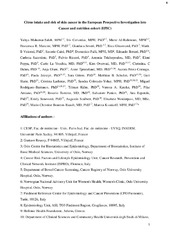Citrus intake and risk of skin cancer in the European Prospective Investigation into Cancer and Nutrition cohort (EPIC)
Permanent link
https://hdl.handle.net/10037/20824Date
2020-07-24Type
Journal articleTidsskriftartikkel
Peer reviewed
Author
Mahamat-Saleh, Yahya; Cervenka, Iris; Al-Rahmoun, Marie; Mancini, Francesca R.; Severi, Gianluca; Ghiasvand, Reza; Veierød, Marit Bragelien; Caini, Saverio; Palli, Domenico; Botteri, Edoardo; Sacerdote, Carlotta; Ricceri, Fulvio; Trichopoulou, Antonia; Peppa, Eleni; La Vecchia, Carlo; Overvad, Kim; Dahm, Christina C.; Olsen, Anja; Tjønneland, Anne; Perez-Cornago, Aurora; Jakszyn, Paula; Grioni, Sara; Schulze, Matthias B.; Skeie, Guri; Lasheras, Christina; Colorado-Yohar, Sandra; RodrÍguez-Barranco, Miguel; Kühn, Tilman; Katzke, Verena A.; Amiano, Pilar; Tumino, Rosario; Panico, Salvatore; Ezponda, Ana; Sonestedt, Emily; Scalbert, Augustin; Weiderpass, Elisabete; Boutron-Ruault, Marie-Christine; Kvaskoff, MarinaAbstract
Citrus intake has been suggested to increase the risk of skin cancer. Although this relation is highly plausible biologically, epidemiologic evidence is lacking. We aimed to examine the potential association between citrus intake and skin cancer risk. EPIC is an ongoing multi-center prospective cohort initiated in 1992 and involving ~ 520,000 participants who have been followed-up in 23 centers from 10 European countries. Dietary data were collected at baseline using validated country-specific dietary questionnaires. We used Cox proportional hazards regression models to compute hazard ratios (HR) and 95% confidence intervals (CI). During a mean follow-up of 13.7 years, 8448 skin cancer cases were identified among 270,112 participants. We observed a positive linear dose–response relationship between total citrus intake and skin cancer risk (HR = 1.10, 95% CI 1.03–1.18 in the highest vs. lowest quartile; Ptrend = 0.001), particularly with basal cell carcinoma (BCC) (HR = 1.11, 95% CI 1.02–1.20, Ptrend = 0.007) and squamous cell carcinoma (SCC) (HR = 1.23, 95% CI 1.04–1.47, Ptrend = 0.01). Citrus fruit intake was positively associated with skin cancer risk (HR = 1.08, 95% CI 1.01–1.16, Ptrend = 0.01), particularly with melanoma (HR = 1.23, 95% CI 1.02–1.48; Ptrend = 0.01), although with no heterogeneity across skin cancer types (Phomogeneity = 0.21). Citrus juice was positively associated with skin cancer risk (Ptrend = 0.004), particularly with BCC (Ptrend = 0.008) and SCC (Ptrend = 0.004), but not with melanoma (Phomogeneity = 0.02). Our study suggests moderate positive linear dose–response relationships between citrus intake and skin cancer risk. Studies with available biomarker data and the ability to examine sun exposure behaviors are warranted to clarify these associations and examine the phototoxicity mechanisms of furocoumarin-rich foods.
Publisher
Springer NatureCitation
Mahamat-Saleh Y, Cervenka I, Al-Rahmoun, Mancini FR, Severi G, Ghiasvand R, Veierød MB, Caini S, Palli D, Botteri E, Sacerdote C, Ricceri F, Trichopoulou A, Peppa E, La Vecchia C, Overvad K, Dahm CC, Olsen A, Tjønneland A, Perez-Cornago A, Jakszyn P, Grioni S, Schulze MB, Skeie G, Lasheras, Colorado-Yohar S, RodrÍguez-Barranco M, Kühn T, Katzke VA, Amiano P, Tumino R, Panico S, Ezponda, Sonestedt E, Scalbert A, Weiderpass E, Boutron-Ruault M, Kvaskoff M. Citrus intake and risk of skin cancer in the European Prospective Investigation into Cancer and Nutrition cohort (EPIC). European Journal of Epidemiology (EJE). 2020;35:1057-1067Metadata
Show full item recordCollections
Copyright 2020 The Author(s)


 English
English norsk
norsk